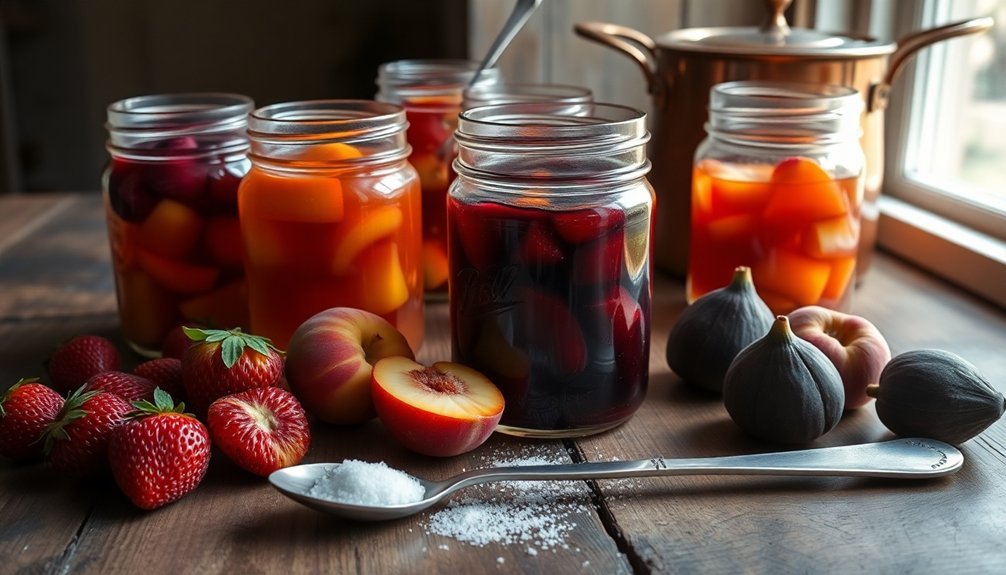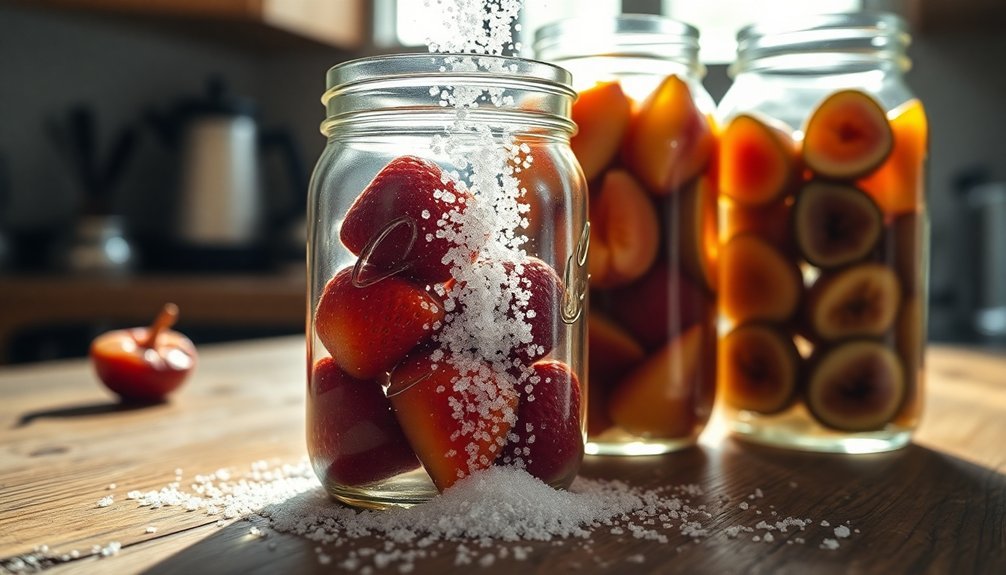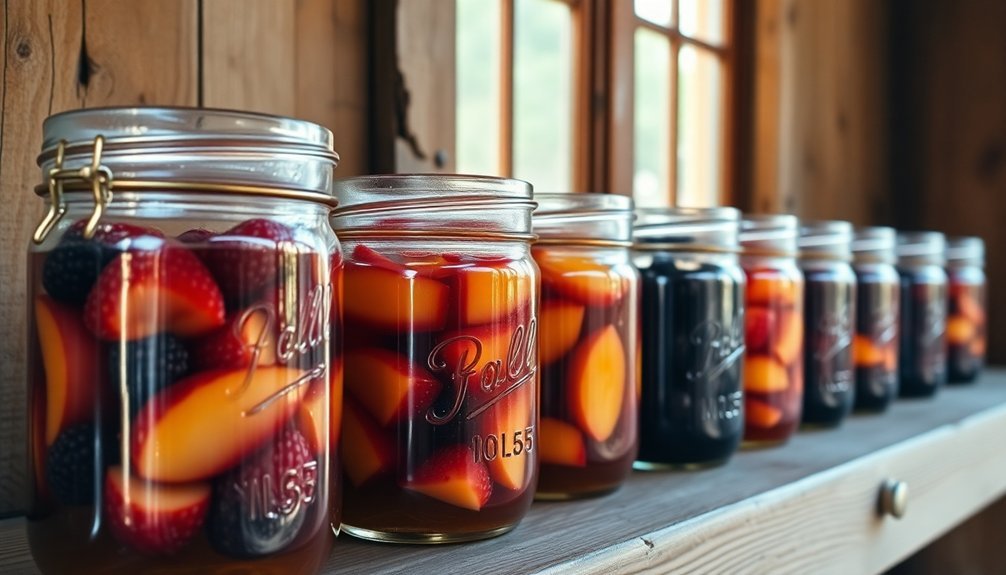You'll find sugar preservation to be one of the most effective and time-tested methods for extending food's shelf life. By creating an environment hostile to harmful microorganisms, sugar draws moisture away from food through osmosis, preventing bacterial growth and spoilage. You can easily implement this preservation technique at home through various methods like canning with sugar syrup, making jams and jellies, or using dry sugar packs for freezer storage. It's a versatile preservation method that not only extends shelf life but also maintains food's natural color, texture, and flavor. Discover how this ancient technique can transform your approach to food storage and preservation.
Sugar's Role in Food Storage

In food storage, sugar serves as a powerful natural preservative by creating an environment where harmful microorganisms can't thrive. When you add sugar to foods, it triggers an osmotic effect that draws water away from the food, reducing water activity and making it difficult for bacteria to survive. This dehydrating action helps protect your stored foods from spoilage while minimizing oxidation that could affect their appearance and texture. This preservation method has been used for centuries to keep foods edible and nutritious.
You'll find sugar particularly effective in extending the shelf life of canned and frozen products. It works by creating a high-sugar concentration environment that prevents microbial growth and helps maintain food quality over time.
When you're preserving fruits and vegetables, the sugar concentration in your syrup is vital – higher concentrations will give you longer storage times, while lighter syrups result in shorter shelf life.
Sugar's preservative power isn't just about preventing spoilage. It's also essential in fermentation processes, where it facilitates the production of beneficial substances like ethanol and organic acids.
These compounds create an acidic environment that further protects your food from unwanted microorganisms while contributing to the preservation of texture, color, and flavor.
Traditional Sugaring Methods
Throughout history, traditional sugaring methods have proven to be one of humanity's most reliable food preservation techniques. Dating back to Alexander the Great's era, both Greeks and Romans discovered that heated sugar combined with fruit pectin could effectively preserve their harvests. Ancient cultures relied on honey for preservation before the widespread use of refined sugar.
In Northern Europe, where sunlight was insufficient for drying foods, sugaring became the preferred preservation method.
You'll find two main approaches to traditional sugaring. The first involves desiccating food through dehydration and packing it with crystalline sugar. The second method requires submerging food in high-density sugar liquid. Both techniques work by reducing water activity, making it impossible for harmful microorganisms to thrive.
When you're preserving fruits through sugaring, you can either store them in sugar syrup or coat them with crystallized sugar after drying. You'll notice that this method helps maintain the food's original texture, shape, and color.
While it's most commonly used for fruits in making jams and jellies, you can also apply sugaring to vegetables and, less frequently, meats. It's particularly effective when you want a sweet alternative to pickling.
Science Behind Sugar Preservation

The science behind sugar preservation explains why these time-tested methods work so effectively. When you add sugar to food, it creates a powerful preservative effect by reducing water activity, which is essential for preventing microbial growth. Sugar molecules bind with water molecules, making them unavailable to microorganisms that need moisture to survive and multiply.
You'll find that sugar's hygroscopic properties play an important role in preservation. It draws moisture out of foods and creates an environment where harmful bacteria, yeasts, and molds can't thrive. Most microorganisms require a water activity level of 0.85 or higher, but sugar preservation reduces this below the critical threshold. The effective nature of sugar preservation has made it especially valuable in canning and fermentation processes.
This preservation method doesn't just protect your food; it also enhances its quality. You'll notice that sugar helps maintain the natural colors of fruits and vegetables by preventing enzymatic browning. It improves texture and contributes to the overall flavor profile of preserved foods.
While sugar preservation requires significant amounts of sugar, which affects nutritional content, it's remarkably effective at extending shelf life and preventing foodborne illnesses by creating an environment where harmful pathogens like Salmonella and Clostridium botulinum can't survive.
Common Applications at Home
Sugar preservation offers several practical applications you can easily implement in your home kitchen.
You'll find sugar playing an essential role in extending shelf life and maintaining food quality across various preservation methods. Whether you're canning fruits, making jams, or pickling vegetables, sugar helps create an environment that inhibits microbial growth while enhancing texture and flavor.
Here are the main ways you can use sugar preservation at home:
- Fruit Canning – You can preserve fruits using sugar syrup to maintain texture and quality. While it's possible to use water or juice, sugar syrup provides the best results for long-term storage.
- Freezer Preservation – When freezing fruits, you'll want to use either a dry sugar pack or syrup pack. The sugar helps protect the fruit's texture by controlling ice crystal formation.
- Pickling Solutions – You'll need sugar in your pickling brine to balance acidity and create an environment that prevents spoilage while adding flavor.
- Jam and Jelly Making – Sugar's important for proper gel formation and preservation. If you reduce sugar content, you'll need to store your preserves in the refrigerator and use them within six months.
Storage Guidelines and Best Practices

Proper storage practices can greatly extend the life and maintain the quality of your preserved foods. When storing sugar, you'll want to keep it in a cool, dry place away from direct sunlight and strong odors.
Don't store it in your refrigerator, as this can cause unwanted clumping and hardening.
Select the right containers for your storage needs. You can use airtight, moisture-proof options like polyethylene bags, Mylar bags, food-grade plastic buckets, or glass canning jars.
For liquid sweeteners like honey, stick to glass containers or #10 cans, avoiding metal containers that might rust.
You'll need to take extra precautions to prevent moisture absorption and clumping. Consider using moisture absorbers or silica gel packets, especially for brown sugar.
If you're storing brown sugar specifically, you can maintain its moisture by adding a slice of bread to the container.
For any sugar that does develop clumps, you can break them down using a food processor or brief microwave intervals.
When stored properly, sugar has an indefinite shelf life. Even if it crystallizes or becomes lumpy, it remains safe to use and can be restored to its original state.
Frequently Asked Questions
Can Sugar-Preserved Foods Be Consumed by Diabetics Safely?
You should avoid sugar-preserved foods if you're diabetic, as they can spike your blood glucose dangerously. If you must eat them, do so sparingly and monitor your levels carefully. Consider sugar-free alternatives instead.
How Does Altitude Affect Sugar Preservation Techniques and Cooking Times?
You'll need to adjust cooking times and temperatures at higher altitudes. Lower boiling points mean you'll reduce finish temperatures by 2°F per 1,000 feet elevation and increase processing times to guarantee proper food preservation.
Why Do Some Sugar-Preserved Foods Ferment While Others Don't?
You'll find that foods ferment when they have the right balance of sugar and moisture. If there's too much sugar, it prevents microbial growth, while the perfect ratio allows beneficial microorganisms to thrive.
Does Using Organic Versus Refined Sugar Affect Preservation Quality?
No, you won't see any difference in preservation quality between organic and refined sugar. They both work equally well to preserve food since they share the same chemical properties for reducing water activity and inhibiting bacteria.
Can Frozen Fruits Be Effectively Preserved Using Sugar Preservation Methods?
You can effectively preserve frozen fruits with sugar by using dry sugar packs or syrup methods. It'll protect texture, maintain color, and enhance flavor while preventing ice crystal damage during freezing.
In Summary
You'll find sugar preservation remains one of the most reliable ways to extend your food's shelf life. Whether you're making jams, candying fruits, or creating syrups, these time-tested methods work because sugar binds water and inhibits bacterial growth. Start with small batches, follow proper storage guidelines, and you'll master this ancient preservation technique that's still perfectly relevant in today's kitchen.





Leave a Reply